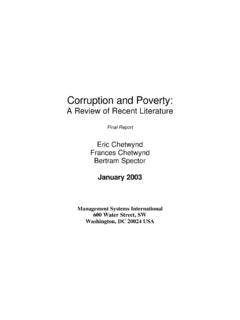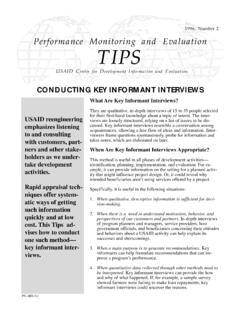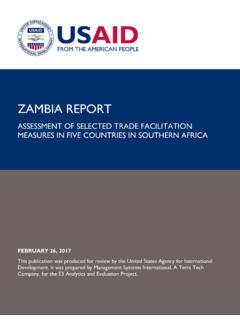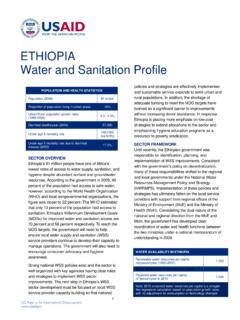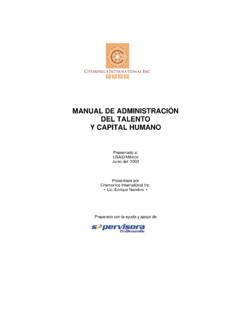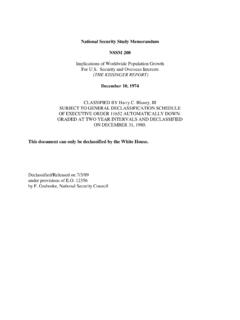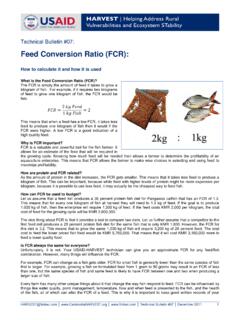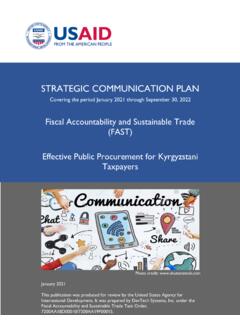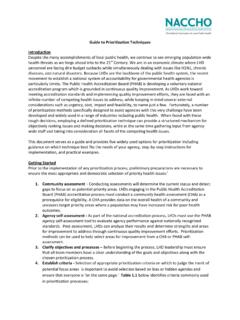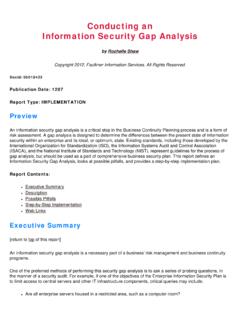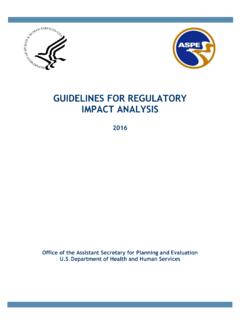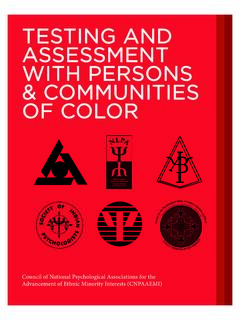Transcription of Tips for Conducting a Gender Analysis at the Activity or ...
1 Tips for Conducting a Gender Analysis at the Activity or Project Level I. What is Gender Analysis ? Gender Analysis is a systematic analytical process used to identify, understand, and describe Gender differences and the relevance of Gender in a specific context. Such Analysis typically involves examining the differential impact of development policies and programs on women and men, and may include the collection of sex-disaggregated or Gender sensitive data. Gender Analysis examines the different roles, rights, and opportunities of men and women as well as relations between them. It also identifies disparities, examines why such disparities exist, determines whether they are a concern, and looks at how they can be addressed. Although Gender Analysis can be conducted at the strategic, AO, project or Activity level, the purpose of this document is to provide practical guidance for carrying out Gender Analysis in the context of project or Activity design.
2 Why should you do a Gender Analysis when you are designing a new project or activity1? To analyze Gender roles in the context of the project or Activity that will be designed. To identify root causes of existing Gender inequalities in that context and increase understanding about how to address them. To identify different needs and priorities of men and women, over the short and long-term. To collect sex-disaggregated baseline data. To avid perpetuating traditional power imbalances. To enhance the likelihood of strengthened and sustainable project or Activity results. Because it's required by the ADS! II. Relevant sections of the ADS: The ADS contains many sections with provisions related to Gender Analysis . Below are those sections that deal with Gender Analysis at the project or Activity level. Section (Project/ Activity Planning Step 2: Conduct Project-Level Analyses, as Needed) specifies that in order to ensure that USAID assistance makes the optimal possible contribution to Gender equality in Conducting Gender analyses for projects or activities, Operating Units must consider the following two questions: 1.
3 Material in this list was adapted from training materials provided by Gender Equality Incorporated in 2009. 1. How will the different roles and status of women and men within the community, political sphere, workplace, and household (for example, roles in decision making and different access to and control over resources and services). affect the work to be undertaken? The purpose of the first question is to ensure that: 1) the differences in the roles and status of women and men are examined, and 2) any inequalities or differences that will impede achieving project or Activity goals are addressed in the project or Activity design. How will the anticipated results of the work affect women and men differently? The second question calls for another level of Analysis in which the anticipated project or Activity results are: 1) fully examined regarding the possible different effects on women and men and 2) the design is adjusted as necessary to ensure equitable and sustainable project or Activity impact .
4 This section also specifies that all projects and activities must address Gender issues in a manner consistent with the findings of any analytical work performed during development of the Mission's long-term plan (see Section ) or for project or Activity design, as described above. The conclusion of any Gender analyses must be documented in the Activity Approval Document (AAD), unless it has been determined that Gender is not a significant issue, in which case this must be stated in the AAD. In addition, the findings of any analytical work performed during the development of a project or Activity design must be integrated into the Statement of Work/requirements definition or the Program Description when the project Activity is to be implemented through an acquisition or assistance award. This ensures that when grantees or contractors carry out the projects or programs, the identified Gender issues are not overlooked.
5 These provisions are also designed to ensure that USAID does not rely solely on vague language in SOWs asking implementers to identify any relevant Gender issues. Section (Reflecting Gender Issues in Performance Indicators) states that in order to ensure that USAID assistance makes the maximum optimal contribution to Gender equality, performance management systems and evaluations must include Gender sensitive indicators and sex-disaggregated data when the technical analyses supporting the AO, project, or Activity demonstrate that there are Gender issues that must be considered. Gender sensitive indicators are described as information collected from samples of beneficiaries using qualitative or quantitative methodologies or looking at the impact the project had on national, regional, or local policies, programs, and practices that affect men and women.
6 This section of the ADS also instructs AO Teams to look for unintended consequences that may need to be addressed over the course of the project. Section (Incorporating Gender Issues into Solicitations) states that for all solicitations including RFPs and RFTOPs, the Contracting Officer must ensure that the requiring office integrated Gender issues into the procurement request or provided a rational as to why Gender is not an issue. This section of the ADS further elaborates that When the procurement request integrates Gender issues into the different contract 2. performance components, , Statement of Work, project deliverables, key personnel qualifications, and monitoring and evaluation requirements, the contracting officer must work with the technical office to ensure that the technical evaluation criteria ( , technical understanding and approach, monitoring and evaluation, personnel, etc.)
7 Correspond to these contract performance requirements. Within these major evaluation criteria, however, Gender issues should not be separate sub-criteria with maximum possible points assigned to them, since this dilutes their significance . Section (Evaluation Criteria) reiterates the main provisions of section but with respect to all USAID-funded activities such as RFAs (including LWA. awards) and APSs ad requires the Agreement Officer to ensure that this has been done. III. Process What should you do to collect the information you need to conduct a Gender Analysis at the Activity or project level? Search for and read recent Gender assessments or sectoral Gender analyses that have been conducted by USAID or others for the countries in which your project will be implemented. Gender assessments for countries in which USAID works are collected on the WID website at work/cross- cutting programs/wid/ Gender / Gender Bureau Gender Advisors also generally maintain updated collections of Gender assessments for their geographic region.
8 The conclusions of country level or sectoral Gender analyses should be used to shape and inform the specific questions that are asked about Gender at the project or Activity level. Consult with Gender experts at NGOs, donor, and other organizations who may be able to outline key Gender issues in the countries and the sector that will be the focus of your project. If the project is a follow-on to a similar project, consult with the implementers of the original project and inquire about any Gender issues that they may have integrated into their programming, Gender issues that may have arisen as they implemented their project, or unexpected consequences of the project in terms of the relationships between men and women or the status of either sex. Examine available quantitative and qualitative data that may reveal relevant Gender issues in the sector in which you plan to work.
9 Consult with women and men in the countries and/or communities where the project will be implemented to solicit their perceptions of whether the project will result in equal outcomes for men and women and to reveal Gender issues that may not have been considered in the initial stages of project design. IV. What questions should you ask in the context of doing your Gender Analysis ? There are many different Gender Analysis frameworks that outline the types of questions that could be asked while Conducting a Gender Analysis . The choice of a particular framework is up to each individual and in many cases, portions of several 3. different frameworks may be relevant. The Six Domains of Gender Analysis is a framework that has been developed and used to collect and organize information pertaining to Gender differences in the health area by the USAID's IGWG (Interagency Gender Working Group)2.
10 This framework is also applicable to most other areas in which USAID works. Listed below are the six general areas that should be examined in Conducting a Gender Analysis utilizing this framework. Many of those who are working on project or Activity design find that the most difficult aspect of carrying out a Gender Analysis is translating these conceptual domains into specific questions in the context of a given design. To illustrate how this can be done in a concrete way, for each domain below examples of specific questions that could be asked in the context of designing an entrepreneurship program are included3. Similar, more specific questions would need to be developed for projects in other areas or sectors by those who are Conducting the Gender Analysis . Access this refers to being able to use the resources necessary to be a fully active and productive participant (socially, economically, and politically) in society.
